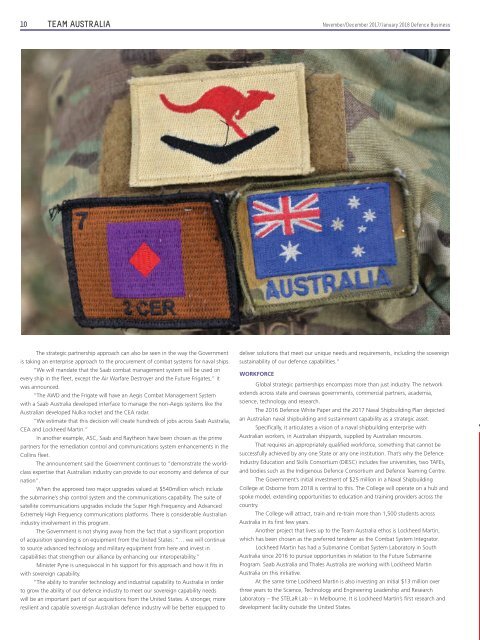Defence Business_Issue 41 (Nov 17 – Jan 18)_DTC_Web
Create successful ePaper yourself
Turn your PDF publications into a flip-book with our unique Google optimized e-Paper software.
TEAM AUSTRALIA<br />
10 <strong>Nov</strong>ember/December 20<strong>17</strong>/<strong>Jan</strong>uary 20<strong>18</strong> <strong>Defence</strong> <strong>Business</strong><br />
The strategic partnership approach can also be seen in the way the Government<br />
is taking an enterprise approach to the procurement of combat systems for naval ships.<br />
“We will mandate that the Saab combat management system will be used on<br />
every ship in the fleet, except the Air Warfare Destroyer and the Future Frigates,” it<br />
was announced.<br />
“The AWD and the Frigate will have an Aegis Combat Management System<br />
with a Saab Australia developed interface to manage the non-Aegis systems like the<br />
Australian developed Nulka rocket and the CEA radar.<br />
“We estimate that this decision will create hundreds of jobs across Saab Australia,<br />
CEA and Lockheed Martin.”<br />
In another example, ASC, Saab and Raytheon have been chosen as the prime<br />
partners for the remediation control and communications system enhancements in the<br />
Collins fleet.<br />
The announcement said the Government continues to “demonstrate the worldclass<br />
expertise that Australian industry can provide to our economy and defence of our<br />
nation”.<br />
When the approved two major upgrades valued at $540million which include<br />
the submarine’s ship control system and the communications capability. The suite of<br />
satellite communications upgrades include the Super High Frequency and Advanced<br />
Extremely High Frequency communications platforms. There is considerable Australian<br />
industry involvement in this program.<br />
The Government is not shying away from the fact that a significant proportion<br />
of acquisition spending is on equipment from the United States: “… we will continue<br />
to source advanced technology and military equipment from here and invest in<br />
capabilities that strengthen our alliance by enhancing our interoperability.”<br />
Minister Pyne is unequivocal in his support for this approach and how it fits in<br />
with sovereign capability.<br />
“The ability to transfer technology and industrial capability to Australia in order<br />
to grow the ability of our defence industry to meet our sovereign capability needs<br />
will be an important part of our acquisitions from the United States. A stronger, more<br />
resilient and capable sovereign Australian defence industry will be better equipped to<br />
deliver solutions that meet our unique needs and requirements, including the sovereign<br />
sustainability of our defence capabilities.”<br />
WORKFORCE<br />
Global strategic partnerships encompass more than just industry. The network<br />
extends across state and overseas governments, commercial partners, academia,<br />
science, technology and research.<br />
The 2016 <strong>Defence</strong> White Paper and the 20<strong>17</strong> Naval Shipbuilding Plan depicted<br />
an Australian naval shipbuilding and sustainment capability as a strategic asset.<br />
Specifically, it articulates a vision of a naval shipbuilding enterprise with<br />
Australian workers, in Australian shipyards, supplied by Australian resources.<br />
That requires an appropriately qualified workforce, something that cannot be<br />
successfully achieved by any one State or any one institution. That’s why the <strong>Defence</strong><br />
Industry Education and Skills Consortium (DIESC) includes five universities, two TAFEs,<br />
and bodies such as the Indigenous <strong>Defence</strong> Consortium and <strong>Defence</strong> Teaming Centre.<br />
The Government’s initial investment of $25 million in a Naval Shipbuilding<br />
College at Osborne from 20<strong>18</strong> is central to this. The College will operate on a hub and<br />
spoke model, extending opportunities to education and training providers across the<br />
country.<br />
The College will attract, train and re-train more than 1,500 students across<br />
Australia in its first few years.<br />
Another project that lives up to the Team Australia ethos is Lockheed Martin,<br />
which has been chosen as the preferred tenderer as the Combat System Integrator.<br />
Lockheed Martin has had a Submarine Combat System Laboratory in South<br />
Australia since 2016 to pursue opportunities in relation to the Future Submarine<br />
Program. Saab Australia and Thales Australia are working with Lockheed Martin<br />
Australia on this initiative.<br />
At the same time Lockheed Martin is also investing an initial $13 million over<br />
three years to the Science, Technology and Engineering Leadership and Research<br />
Laboratory <strong>–</strong> the STELaR Lab <strong>–</strong> in Melbourne. It is Lockheed Martin’s first research and<br />
development facility outside the United States.


















